500 of us built a city of clay at Bellastock in Paris
Published 24 July 2017 by Caroline Grellier
To build an ephemeral city out of raw clay in less than 48 hours with 500 pairs of hands: this was the festival challenge of the experimental architecture organization Bellastock.
Every year since 2006 in greater Paris, Bellastock has been organizing and hosting a collective construction festival in order to explore the problems linked to urban space, as if inside a lifesized lab. This year, from July 13 to 16 around the theme “City of clay”, CRAterre, Amàco and Bellastock collaborated to stimulate reflection on reusing 50 million tons of earth left over from the construction sites of the Grand Paris.
It was a way of both demonstrating the high-impact socio-economical and ecological potential of building out of raw earth and calling attention to the fact that this earth is not debris but indeed a prime material for construction. This environmental concrete could play a significant role in low-carbon projects. The key issue was to prove that a commercial market for earth exists.
The challenge posed to the 500 participants (architecture students, fans of collective construction sites, designers, young architects…) consisted of building and inhabiting an ephemeral city in two days, before opening it to the public and then destroying it on the fourth and final day. I was a member of one of the hundred teams on site.
July 13. Building shelter for tonight
Suddenly, the RER train’s Saint-Denis station looks like a summer camp. I join my team, mostly made up of friends from Ecole Boulle: Jeanne Guyon, Diane Barbier, Capucine Blanchard and Alexandre Motto. No need to ask for directions, we simply join the flow of walking backpacks carrying shovels, pails and camping gear.
After walking for 30 minutes, we finally discover the site, near the eco-neighborhood along the river of Ile-Saint-Denis. It’s a vast field under construction, where a total of 14,000 square meters of earth will be excavated. The site already hosts Actlab, Bellastock’s experimental lab, which cultivates the art of reusing in Seine-Saint-Denis.
As soon as we arrive, we choose our mound of earth and our pallet of 250 compressed earth bricks (CEB), which determines our 9m2 “territory” to be invested.

Following a briefing about material, security and organization, we’re off! The goal of this first day is to build our shelter and sleep in it that same night. At that moment, standing with my team before this great mound of earth, I feel slightly perplexed about the feasability of the deadline.
Without giving it too much thought, we attend the workshops designed to give us a crash course on various techniques for transforming earth and clay. I don’t hesitate to get my hands dirty—literally, as the first step is to make balls from a special mixture of earth and water, which we then slab together to form layers. Once dry, the wall is pretty solid.

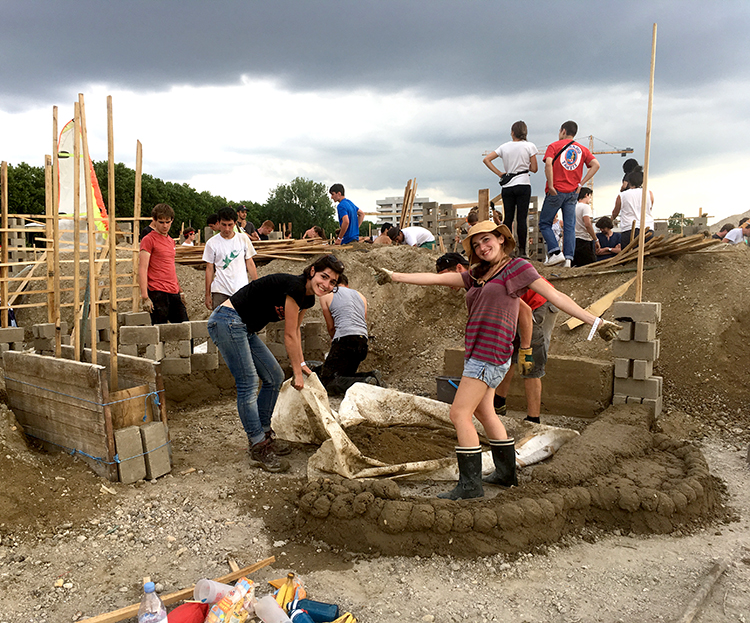
In the beginning it was fun stomping down the earth and throwing our clay balls, but after a few hours, we decide to proceed to the CEB. Within a few minutes, we select our reserve of bricks and build the façade of our shelter in no time.
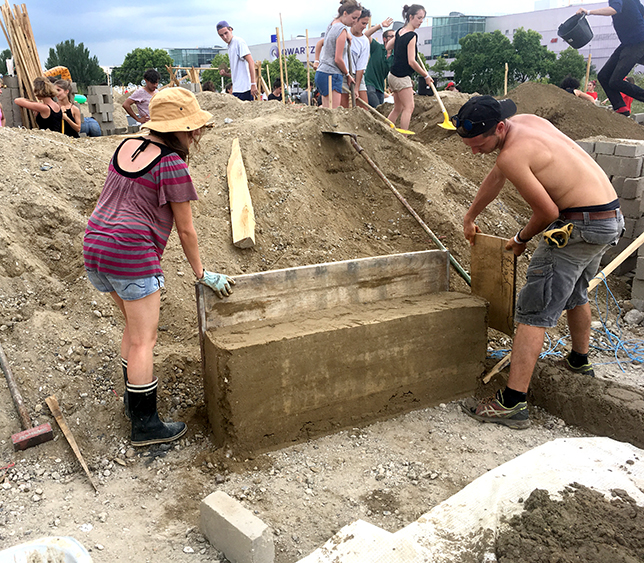
Thus remotivated, we move on to experiment with another technique: rammed earth. It’s earth rammed together and shaped into a rectangular form by four perpendicular planks of wood. Muscles are hard at work. Two hours later, we have two little walls to define our house.
After all our efforts, it’s time for comfort—the Disco Soupe collective prepares all our meals from unnsold fruits and vegetables, including more than 600kg of bananas, which we sampled in every way possible, thank you!
Back in the field, we escaped a disaster: our neighbors, in charge of building the common wall between us, made a CEB structure that crumbled under our eyes… onto our side. As the bricks are laid without mortar, it’s essential to build walls at an angle and place each brick carefully.
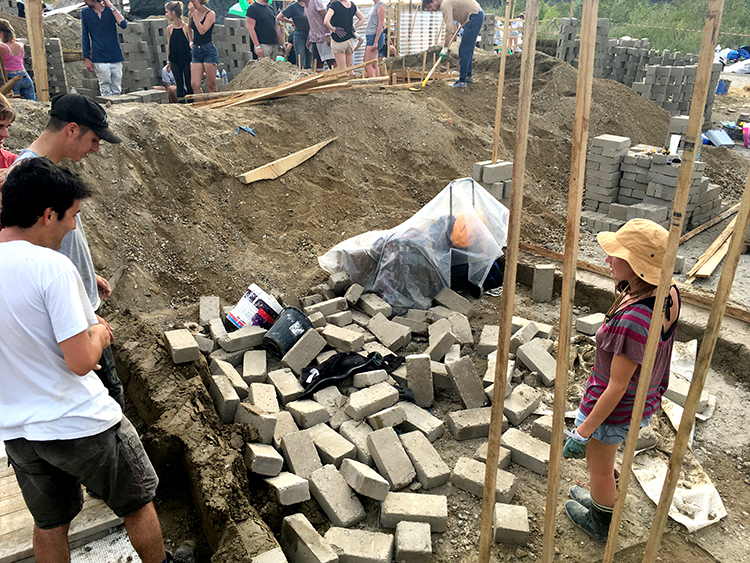
Warmed up from lunch, we begin making our roof. Brackets made from reclaimed wood and polycarbonate sheets are all we have to work with. No nails, screws, glue… we learn to be inventive with cord.
By around 9pm, we cut the last strings. Challenge met, in good humor, nobody hurt. I look up and am surprised to see our city, built by 500 pairs of hands. Seen from above, the city of clay looks a bit like a slum. Dense, patched together, but creative. We did it!
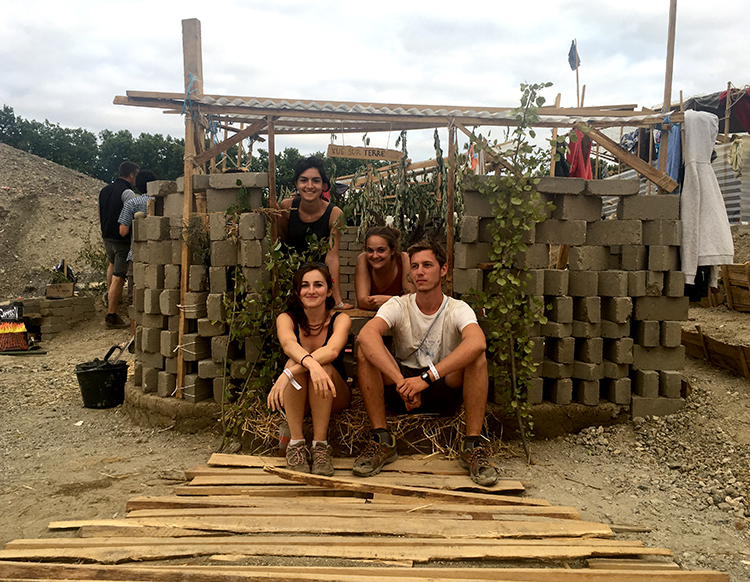
Fatigue, accompanied by muscleache, gently sets in. After dinner, given the cool air and slight trauma of tumbling CEB, we decide to sleep in the tent…
Timelapse of first day of Bellastock 2017, by Alexis Leclercq:
July 14. Collectively settling in
We awake with a smile thanks to TéléCharette, the festival radio broadcast in charge of keeping us motivated from morning to night with music and jokes. The wind blew off a few roofs, but overall, our city stands intact.
Today, we install the collective elements: walls, gardens, stairs, alleyways, plaza. We coordinate with our neighbors to make our neighborhood attractive to visitors. By tomorrow Saturday, the festival will be open to the public.
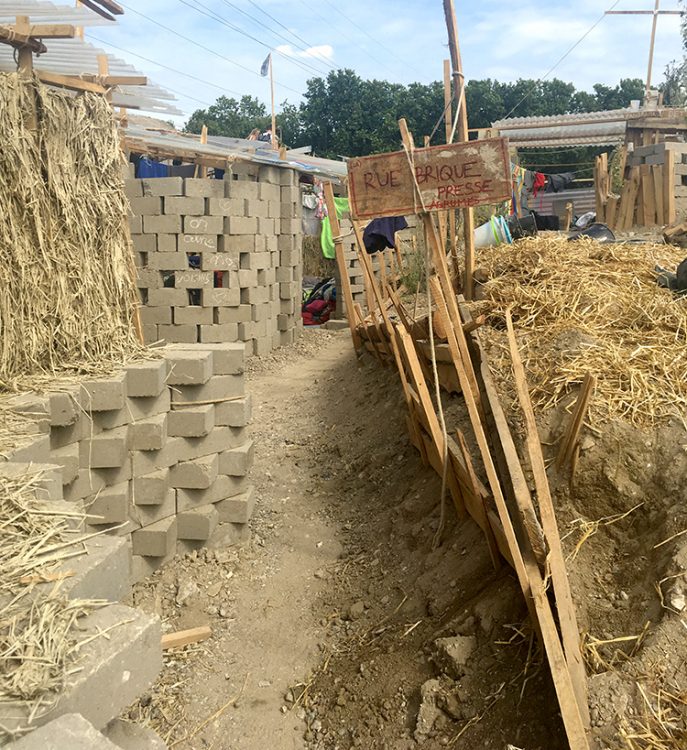
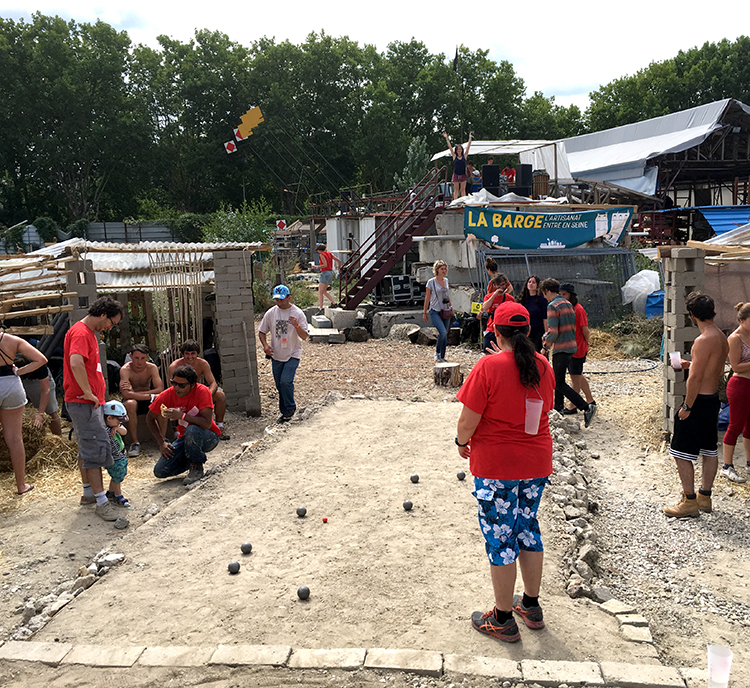
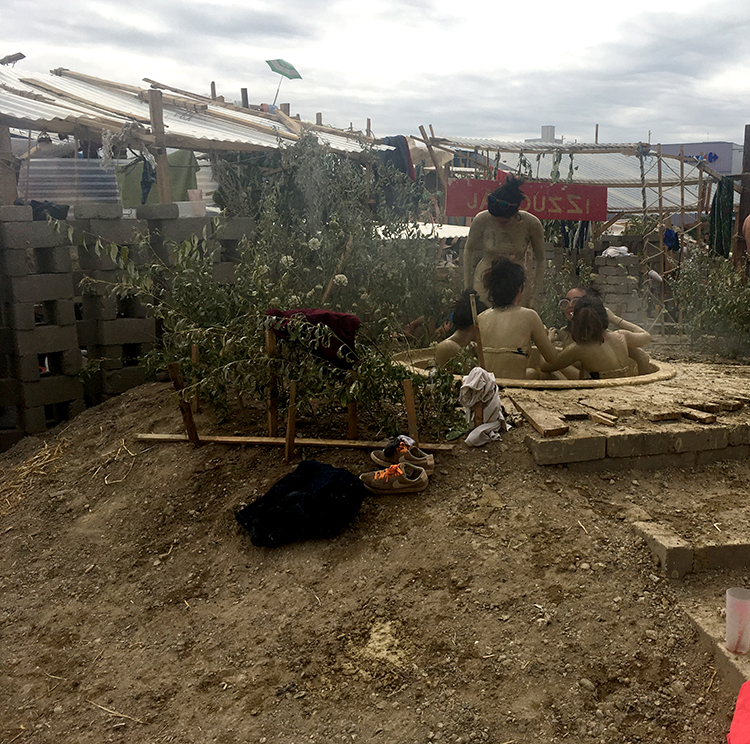
Back to work with shovels and pails in hand to clear the way. One team volunteers to build a “jabouzzi”, or a reclaimed jacuzzi tub offering mudbaths, architecture students from Marseille live up to their reputation by building a petanque field, while others treat us to a crepe stand.
My team refines our shelter by reinforcing the roof and furnishing the inside with a table and benches made from bricks, wood and pallets.
July 15. Welcome to the City of clay!
Vistors arrive, families, friends, surprised to see how this city of clay emerged from the earth in less than 48 hours. I must admit, we’re also the first to be surprised by this collective effort.
In the afternoon, a round table bringing together elected officials and architects raises this very issue of collectively building the city.
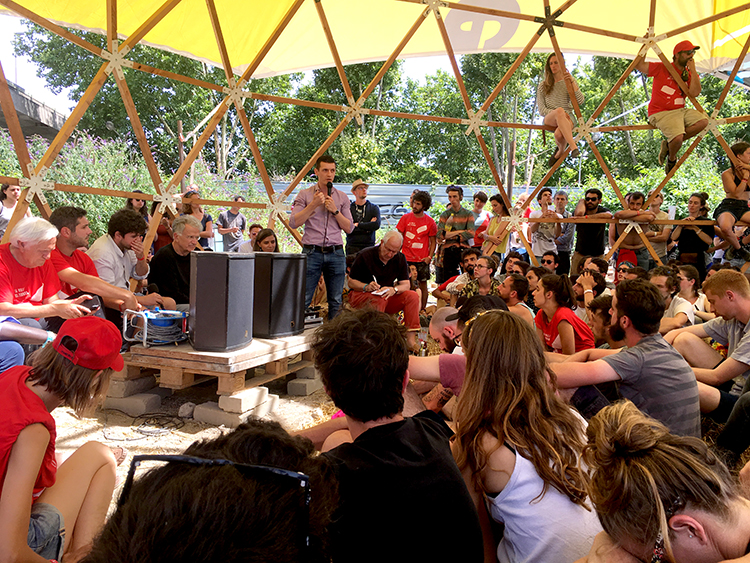
As this Saturday is for relaxing, I also take some time to visit our city, wandering through the site to check out the various tricks and techniques used by each team.
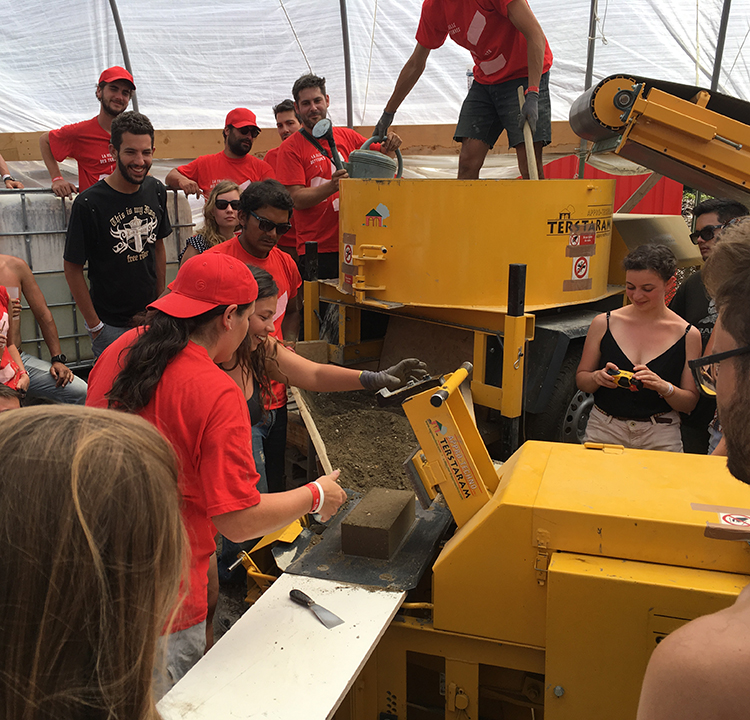
By the end of the day, Bellastock feels more like a festival than a construction site, with concerts and artisanal beer, all under a highway overpass. A somewhat hippie vibe weaves its way through this improbable decor hosting a Woodstock-like party.
July 16. Deconstruction
Rude awakening—muscleache from three intensive days on the construction site, or hangover from last night’s Congolese rumba? Who knows. The festival radio uses its artillery of imagination and humor to draw us out of bed. My team slept in our house—or stable, on beds of straw.
A coffee and a sunburn later, we start deconstructing our city. Well, at least it always goes faster in this direction…
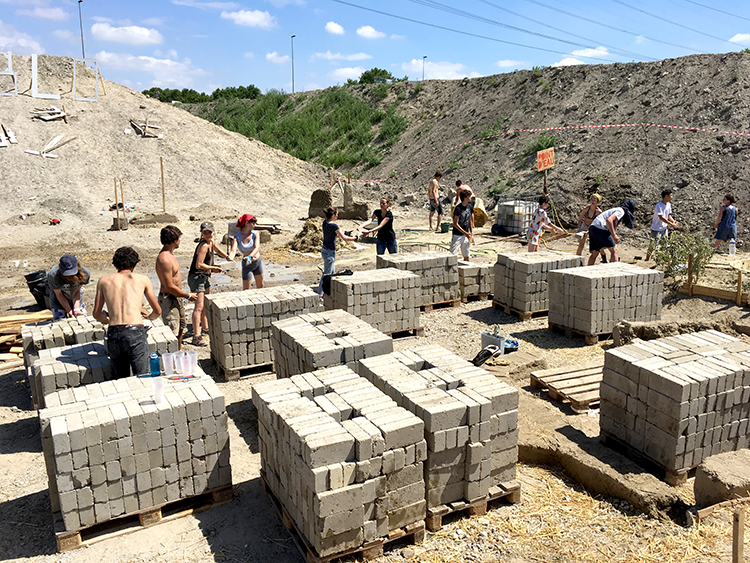
Human chains of more than 50 people form in the alleys to restack the CEB on pallets, which, like the earth, will be reused. The radio makes me laugh, with its sports commentary on our deconstructing performances assimilated to the Olympics, informal announcements… it’s a fun atmosphere.
In summary, the festival was expertly organized to give us lots of knowledge and skills through practice in a unique environment that left us free to experiment and have fun. We 500 little ants each completed our mission with three words on our lips: “I’ll come back.”
More info on the city of clay (in French): La ville des terres (website and Facebook)
